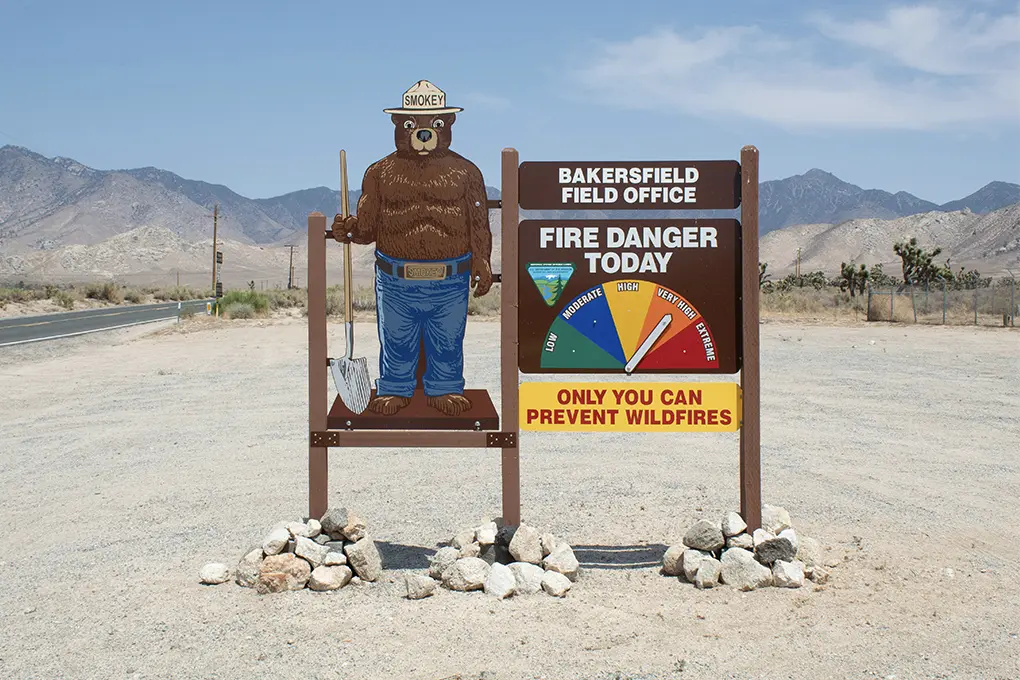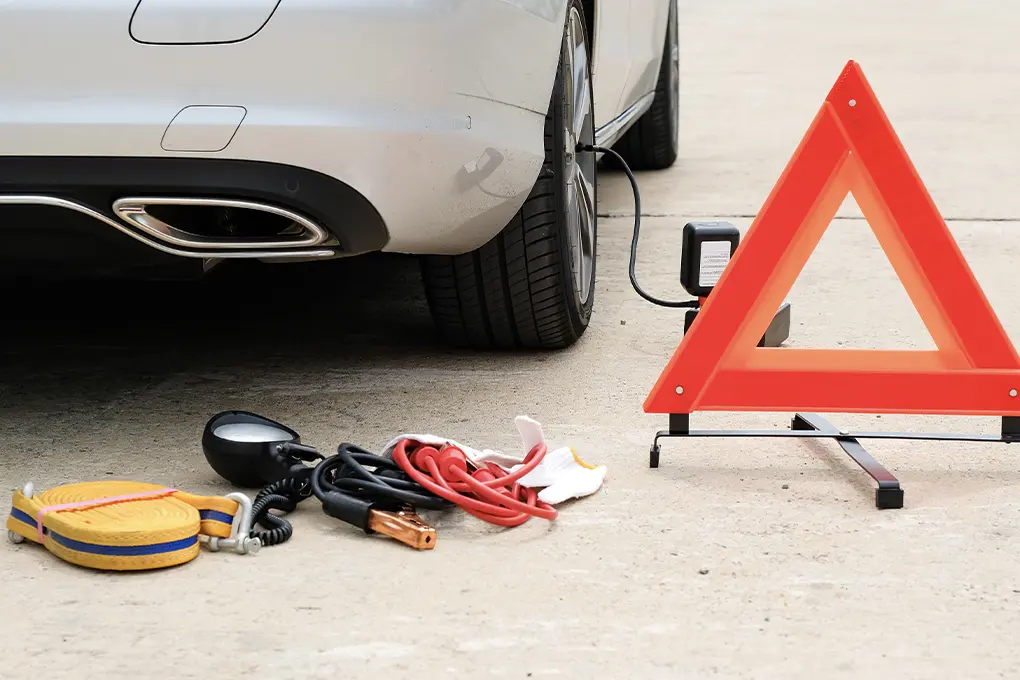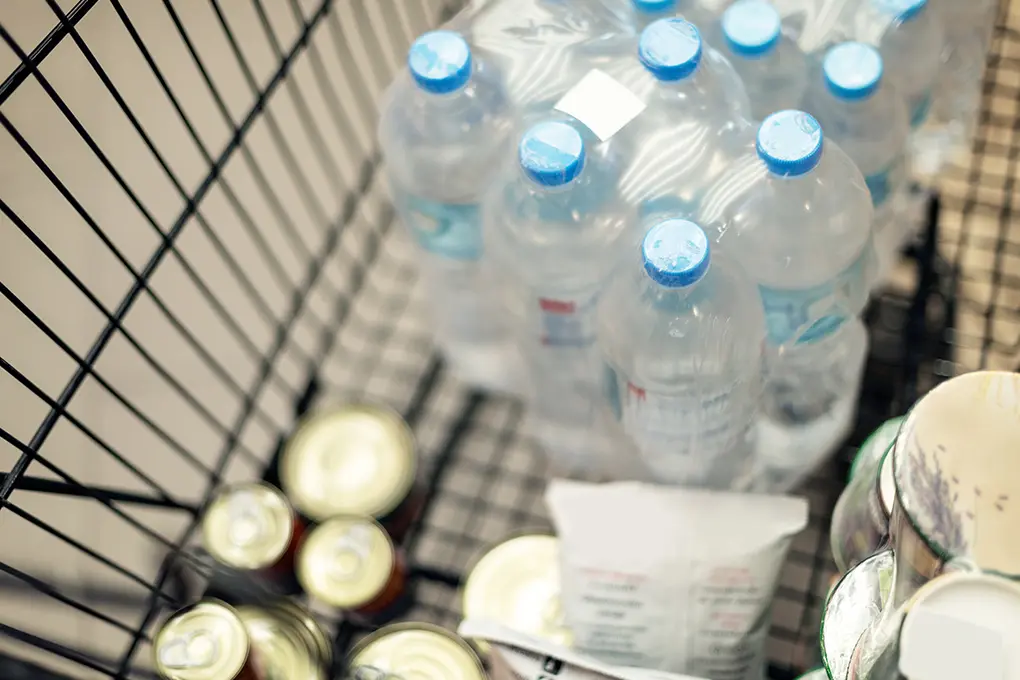In recent years, wildfires have become increasingly destructive and unpredictable. According to USA Facts, the United States has experienced an average of 62,277 wildfires annually in the past decade, burning an average of 7.02 million acres each year.
Even more telling, according to the National Interagency Fire Center, since January 1, 2025, 17,400 wildfires have burned over 822,000 acres of land across the USA. Not only do wildfires threaten the safety and lives of everyone they come in contact with, but they also cause untold economic damage.
The devastation isn’t limited to rural areas. Suburban neighborhoods and even city outskirts have faced unprecedented threats as fire seasons grow longer and more intense.
For instance, the recent LA wildfires are estimated to have caused upwards of $250 billion in economic losses and damages. The damages caused by this single wildfire exceeded the total financial losses of the entire 2020 wildfire season in California, illustrating the worsening severity and impact of wildfires.
As someone who’s lived in wildfire-prone regions for over a decade, I’ve learned that preparation is essential. The difference between safely evacuating with your important possessions intact and facing a desperate situation often comes down to having a solid plan before smoke appears on the horizon.
This comprehensive guide will cover everything you need to know about preparing for wildfires, creating an effective evacuation plan, and keeping your family and property as safe as possible during these increasingly common disasters.
This is your complete wildfire preparedness and evacuation guide. Let’s help keep you and your family safe.
Contents
Key Takeaways
- Wildfire preparation should begin long before an emergency occurs.
- Creating defensible space around your home significantly improves wildfire resilience.
- Home hardening with fire-resistant materials reduces the risk of structural loss.
- An evacuation kit tailored specifically to wildfire scenarios is crucial.
- Practicing your evacuation plan helps ensure quick, effective action during emergencies.
- Community-level wildfire preparedness significantly boosts safety and response efficiency.
- Staying informed through emergency alert systems provides valuable extra time during evacuations.
Before a Wildfire: Creating Your Defense Plan
The most effective wildfire protection happens long before a fire threatens your area. A proactive approach includes both hardening your home against potential fire exposure and preparing for a possible evacuation.
How to Prepare Your Home for Wildfire Season
Creating a defensible space around your property is your first line of defense against wildfires. This involves managing vegetation and other combustible materials to reduce fire intensity and slow its spread.
According to the National Fire Protection Association, homes with proper defensible space are significantly more likely to survive a wildfire.
Here’s how to create effective defensible zones:
Zone 1 (0 to 5 Feet From Home): This immediate zone is critical for preventing embers from igniting your home. Research from the Insurance Institute for Business & Home Safety shows that flying embers can ignite homes up to a mile away from the main fire. The goal for this zone is to create a fire-resistant perimeter:
- Remove all dead vegetation, including dried leaves and pine needles from roofs, gutters, porches, and decks
- Replace mulch with non-flammable materials like gravel or stone
- Move firewood piles to Zone 2 (at least 30 feet from structures)
- Trim tree branches that overhang your home, roof, or deck
- Use non-combustible materials for fences, deck boards, and other structures connected to the house
Zone 2 (5 to 30 Feet From Home): In this zone, your goal is to slow and reduce fire intensity, which you can do through the following means:
- Keep lawns mowed to a maximum height of four inches
- Create horizontal spacing between shrubs and trees (the rule of thumb is two to three times the height of the vegetation)
- Remove fallen leaves, needles, twigs, bark, cones, and small branches
- Create vertical separation between grass, shrubs, and trees to prevent “ladder fuels” that allow fire to climb
- Keep trees spaced to prevent touching crowns
Zone 3 (30 to 100+ Feet From Home): This extended zone is about interrupting fire paths, which you can do by:
- Keeping undergrowth cleared and thin out dense tree stands
- Removing heavy accumulations of ground litter/debris
- Removing dead plant and tree material
- Maintaining a minimum of 10 feet between tree canopies
When I moved to a home in California’s Sierra foothills, addressing these zones was my first priority. I spent a full weekend clearing the immediate perimeter of my house, removing all pine needles, trimming back shrubs, and replacing bark mulch with stone.
My neighbors, who had experienced a nearby fire the previous year, shared that this work might seem tedious but could absolutely make the difference between losing and saving a home.
Home Hardening: Structural Preparations
Beyond landscaping, the materials and maintenance of your home itself can significantly impact its fire resistance. According to a 2022 study from the USDA Forest Service, homes with fire-resistant features were up to 40% more likely to survive wildfires.
Focus on these vulnerable areas:
Roof and Gutters
- Install Class A fire-rated roofing materials (metal, clay, or composite tiles)
- Use gutter guards to prevent debris buildup
- Regularly clean gutters and roof valleys
Vents and Openings
- Cover vents with 1/8-inch to 1/4-inch metal mesh to block embers
- Install ember-resistant attic and foundation vents
- Consider installing exterior sprinkler systems designed for wildfire defense
Windows and Doors
- Install dual-paned windows with tempered glass
- Replace wooden window frames with metal or fiberglass
- Use weather stripping around doors to seal gaps
- Consider installing rolling fire shutters for extreme risk areas
Decks and Porches
- Build with fire-resistant materials (composite decking, heavy timber)
- Enclose undersides of decks with fire-resistant materials or 1/8-inch wire mesh
- Keep the area under decks clear of debris and combustible storage
Siding and Exterior Walls
- Consider replacing wooden siding with fire-resistant materials like stucco, fiber cement, or treated wood
- Seal gaps and crevices where embers could lodge
- Inspect and maintain fire-resistant properties of exterior materials
I’ve seen firsthand how these modifications can save homes. During a wildfire that swept through my friend’s neighborhood last summer, his home survived largely because he had installed a Class A metal roof the previous year, while many of his neighbors with traditional asphalt shingles suffered significant damage. The investment might feel steep initially, but the protection it provides is invaluable.
Create Your Wildfire Emergency Kit
Having a specialized emergency kit for wildfires ensures you’re ready to evacuate at a moment’s notice. Unlike general emergency kits, wildfire kits need items specific to the hazards presented by smoke, air quality issues, and potential power outages that often precede evacuation orders. Your wildfire emergency kit should include:
Essential Documents and Information
- Copies of important documents in waterproof, fireproof container
- Insurance policies, property deeds, and birth certificates
- Digital backups on waterproof USB drives
- Contact information for emergency services, family, and insurance agents
- Maps of your region with multiple evacuation routes marked
Air Quality Protection
- N95 respirator masks for each family member (specially fitted for children if available)
- Portable air purifiers with battery backup
- Goggles for eye protection from smoke and ash
- Bandanas or cloth masks (as backup only – N95 masks are far more effective)
Communication and Power
- Battery or hand-crank powered radio with NOAA weather alerts
- Portable phone chargers and extra batteries
- Whistle to signal for help
- Headlamps or flashlights (avoiding open flames from candles)
Water and Food
- At least one gallon of water per person per day for three to seven days
- Non-perishable food items that require no cooking
- Manual can opener
- Pet food and additional water for pets
Find emergency food and water supplies and kits at Batten Emergency.
First Aid and Medications
- Comprehensive first aid kit with burn treatment supplies
- At least a two-week supply of prescription medications
- Non-prescription medications (pain relievers, antacids, etc.)
- Contact lenses/glasses and solution
Clothing and Bedding
- Complete change of clothing for each person (long sleeves/pants preferred)
- Sturdy, closed-toe shoes or boots
- Sleeping bags or blankets
- Fire-resistant blanket (can provide temporary protection in an emergency)
Pet and Livestock Supplies
- Pet carriers and leashes
- Food, water, and medications for pets
- Identification and vaccination records
- Livestock evacuation plan and supplies if applicable
Keep this kit in a dedicated backpack or duffel bag for each family member, located near your vehicle for quick access. Periodically check your supplies, replacing expired items and updating documents as needed.
Having evacuated during the 2020 wildfire season, I can attest that having these items pre-packed was invaluable. The evacuation order came at 2 AM, and having everything ready meant we were on the road within 20 minutes – while some neighbors were still scrambling to gather essentials.
Sign Up for Emergency Alerts and Notifications
Early warning systems can provide the critical time needed to evacuate safely. According to FEMA, having just a few additional minutes of warning time can significantly increase survival rates during disasters. Take these steps to ensure you receive timely alerts:
- Register for your county’s emergency notification system (often called Reverse 911)
- Download the FEMA app for real-time alerts and safety tips
- Sign up for Wireless Emergency Alerts (WEA) on your mobile devices
- Consider a NOAA Weather Radio with battery backup
- Follow local fire departments and emergency management agencies on social media
- Join neighborhood communication groups (apps like Nextdoor can be valuable)
- Install smoke detection and air quality monitoring systems around your property
In our community, we use a combination of official county alerts and a neighborhood text chain. During the last fire evacuation, our neighborhood alert system notified residents about road closures that hadn’t yet been updated in the official emergency alerts, allowing people to avoid dangerous routes.
Create and Practice Your Evacuation Plan
A comprehensive evacuation plan that all household members understand can save precious time during an emergency. The American Red Cross recommends practicing your evacuation plan at least twice a year. Your evacuation plan should include:
Multiple Escape Routes
- Identify at least three evacuation routes from your neighborhood
- Consider routes in all directions, as fire could block certain paths
- Have physical maps available (don’t rely solely on GPS, which may be unavailable)
- Identify temporary meeting places outside the evacuation zone
Family Communication Plan
- Designate an out-of-area contact person all family members can call
- Ensure everyone has emergency contact information memorized or accessible
- Establish a method to mark your home as evacuated (some communities use colored ribbons)
- Create a plan for reconnecting if separated
Transportation Considerations
- Keep vehicle gas tanks at least half full during fire season
- Store emergency supplies in your vehicle during high-risk periods
- Have a backup transportation plan if your primary vehicle is unavailable
- Consider carpooling arrangements with neighbors, especially for those with limited mobility
Evacuation Destinations
- Identify several potential shelter locations in different directions
- Research pet-friendly evacuation centers or accommodations
- Make arrangements with friends or family outside the risk area
- Maintain a list of hotels/motels outside the evacuation zone
Special Considerations
- Plan for evacuating people with disabilities or medical needs
- Have a strategy for evacuating livestock and larger animals early
- Create procedures for securing your home before leaving
- Consider installing emergency release systems for livestock if you might not be home
Our family conducts an evacuation drill every spring before fire season begins. We time how long it takes to grab our go-bags, secure the house, and load the car. Our record is 12 minutes, but we’re aiming to get it under 10 minutes this year. These drills might seem excessive, but when minutes count, muscle memory can be a lifesaver.
During a Wildfire: Evacuation Steps
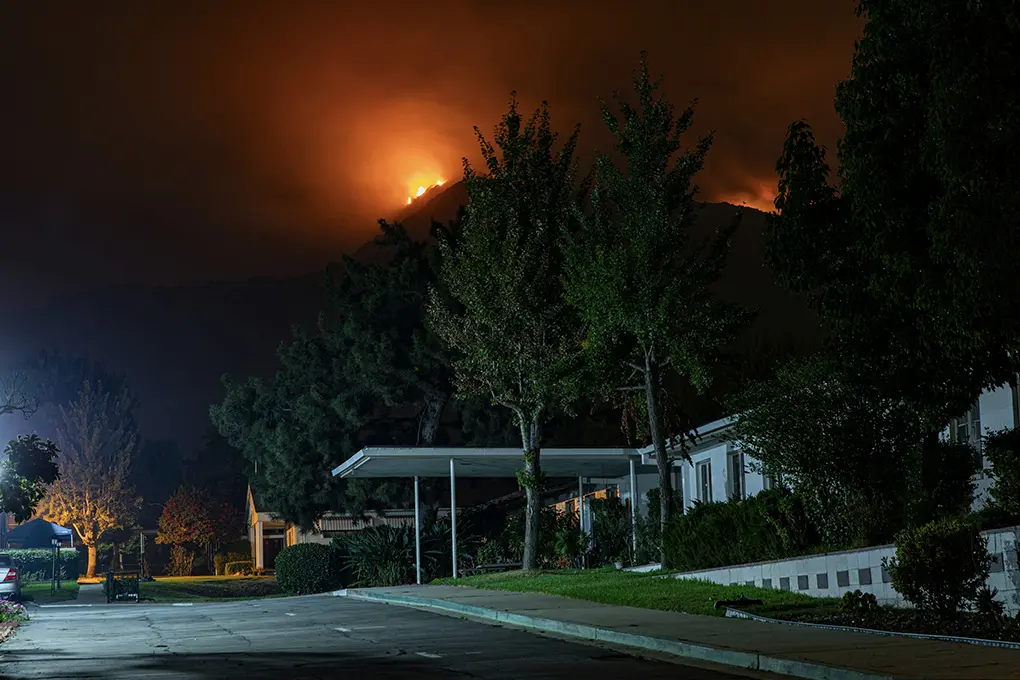
When a wildfire threatens and evacuation becomes necessary, staying calm and following your prepared plan is essential. According to the U.S. Forest Service, many wildfire-related fatalities occur during late or panicked evacuations.
What to Do When Wildfire Threatens Your Area
Monitor Conditions and Stay Informed: Even before official evacuation notices, you should be alert and preparing when:
- Smoke or haze is visible in your area
- You receive alerts about nearby fire activity
- Weather conditions include red flag warnings (hot, dry, windy)
- Local authorities issue fire weather watches
I’ve learned to start preliminary preparations at the first sign of smoke, even if it seems distant. During the 2021 fire season, what looked like a small, distant smoke column grew into a major evacuation within just three hours. Those who waited for official notices had much less time to prepare than those who started early.
Pre-Evacuation Home Checklist
If time allows before evacuation, these steps can help protect your property:
Outside the House
- Bring flammable items from the exterior of the house inside (patio furniture, door mats, toys)
- Move propane BBQ appliances and firewood away from structures
- Connect garden hoses to outside water valves for use by firefighters
- Fill pools, hot tubs, garbage cans, or other large containers with water
- Seal attic and ground vents with pre-cut plywood or commercial seals
- Place a ladder against the house for firefighters to access the roof
- Seal gaps around garage doors with weather stripping or duct tape
Inside the House
- Shut all windows and doors, leaving them unlocked for firefighter access
- Remove flammable window coverings and move flammable furniture to the center of rooms
- Shut off the gas at the meter; turn off pilot lights
- Leave interior lights on so firefighters can see your house in smoke conditions
- Turn off air conditioning systems
- Close fireplace screens and dampers
After experiencing a near-evacuation last year, I created a laminated checklist that hangs on our refrigerator. When the alert came, the checklist helped us stay focused rather than forgetting critical steps due to stress and anxiety.
Evacuation Procedures: When It’s Time to Leave
When evacuation orders are issued, time is critical. According to the California Department of Forestry and Fire Protection (CAL FIRE), you should be prepared to leave immediately under mandatory evacuation orders. Follow these evacuation procedures:
- Get your emergency supply kit and load your vehicle
- Dress for safety: long sleeves, long pants, sturdy shoes, bandana, goggles, and N95 mask if available
- Check on neighbors, especially elderly or disabled individuals
- Take your pets in pet carriers or on leashes
- Lock your home as you leave
- Follow recommended evacuation routes – don’t take shortcuts as they may be blocked
- Drive with headlights on for visibility through smoke
- Keep windows closed, AC set to recirculate to minimize smoke exposure
- Drive calmly and defensively, watching for panicked people or animals
- If you become trapped, call 911 immediately and provide your exact location
During an evacuation from my area in 2019, several people ignored the recommended routes and became trapped on back roads. The designated evacuation routes had been cleared by emergency personnel, while the “shortcuts” some people attempted to use had become blocked by fallen trees. Following official guidance is almost always safer than improvising.
If You Become Trapped
Becoming trapped in a home, vehicle, or on foot may occur during a wildfire. Here are tips to follow to keep you safe and alive if this were to occur:
If Trapped in Your Vehicle
- Stay calm and call 911
- Park in an area clear of vegetation
- Close all vehicle windows and vents
- Cover yourself with a wool blanket or jacket
- Lie on the vehicle floor
- Use your emergency water to wet your clothing if possible
If Trapped in Your Home
- Call 911 to inform authorities of your location
- Fill sinks and tubs with cold water
- Keep doors and windows closed but unlocked
- Stay away from outside walls and windows
- Gather in a room on the side of the building farthest from the approaching fire
If Trapped on Foot
- Call 911 if possible
- Find an area with minimal vegetation, such as a ditch or depression
- Lie face down and cover your body with soil if possible
- Use any water to wet clothing and exposed skin
- Breathe through a wet cloth, staying close to the ground to avoid smoke
A firefighter once told me that most people who survive being trapped have one thing in common: they maintained presence of mind and followed these protocols instead of panicking. The natural instinct to run can sometimes lead people into more dangerous situations.
After a Wildfire: Returning Safely
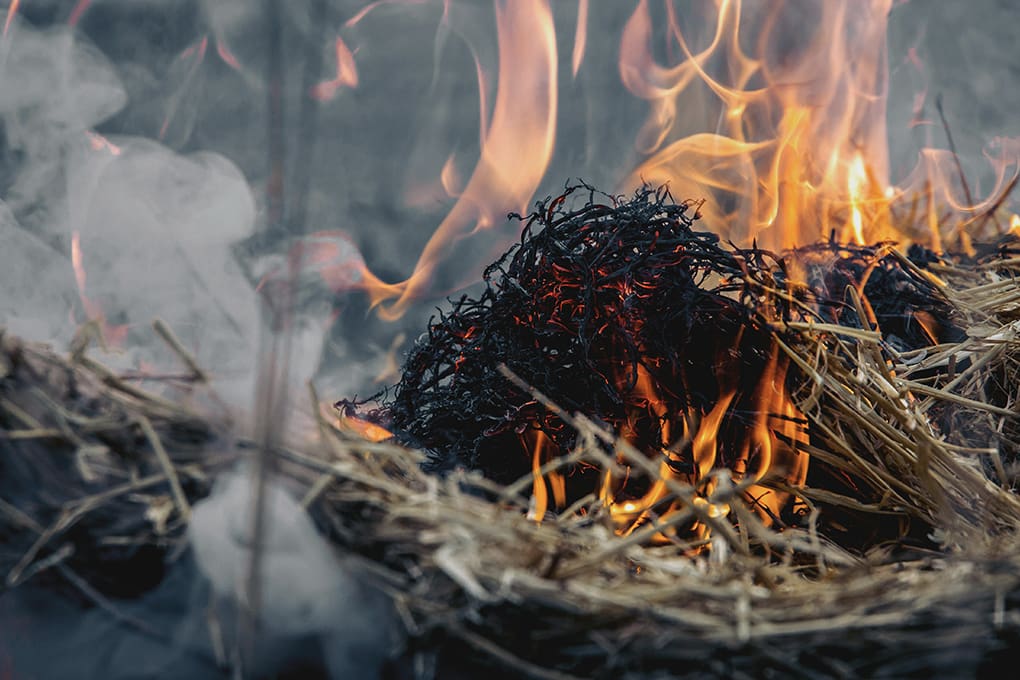
The period after a wildfire can be dangerous and emotionally challenging. The American Red Cross reports that injuries and accidents are common during the return phase after wildfires, often due to hazards like weakened structures, toxic ash, and compromised utilities.
When and How to Return Home
Follow the tips as outlined below for safely returning to your home following a wildfire:
Wait for Official Clearance
- Only return when authorities declare the area safe
- Bring identification and proof of residence (you may need to pass through checkpoints)
- Check with utility companies about the status of services
- Return during daylight hours when hazards are more visible
Approach With Caution
- Watch for damaged power lines, gas leaks, and structural damage
- Be aware of hot spots that may reignite
- Wear protective clothing, including closed-toe shoes, long pants, long sleeves, gloves, and N95 masks
- Carry a first aid kit, flashlight, and a fire extinguisher
Inspect Your Property Carefully
- Check the roof and exterior for embers, sparks, or hidden fires
- Look for smoke or sparks in the attic
- Survey the property for damaged trees that could fall
- Document all damage with photos for insurance claims
- Dispose of food that was exposed to heat, smoke, or firefighting chemicals
When I returned home after a nearby fire, I was surprised to find small hot spots still smoldering in some areas three days later. A thorough inspection of our property revealed embers that had nestled in mulch beds far from the main fire line. Vigilance upon return is absolutely necessary.
Recovery Resources and Support
The recovery process after a wildfire can be lengthy. Several organizations offer resources to help:
- FEMA Disaster Assistance: Apply online at DisasterAssistance.gov
- American Red Cross: Provides emergency shelter, supplies, and emotional support
- Small Business Administration (SBA): Offers low-interest disaster loans to homeowners and businesses
- Local Community Organizations: Often coordinate volunteers and donations
- Crisis Counseling: The SAMHSA Disaster Distress Helpline (1-800-985-5990) provides crisis counseling
Our community created a recovery network after a major fire affected several neighborhoods. Volunteers helped clear debris, provided temporary housing, and even coordinated with insurance adjusters to expedite claims. Don’t hesitate to seek help because recovery is not something anyone should face alone.
Building Community Resilience
Individual preparedness is essential, but community-level planning creates a stronger defense against wildfires. According to the National Fire Protection Association, communities that implement collaborative wildfire safety programs have significantly better outcomes during wildfire events. Consider participating in:
- Firewise USA®: A program that teaches people how to adapt to living with wildfire
- Community Emergency Response Team (CERT): Provides training in basic disaster response skills
- Neighborhood Watch or Emergency Response Groups: Coordinate preparedness efforts and check on vulnerable neighbors
- Local Fire Safe Councils: Work on community-wide fire prevention projects
- Community Cleanup Days: Organize neighborhood events to reduce fuels and create defensible space
After participating in our local CERT program, I helped organize a neighborhood communication system that has since been used during two evacuation warnings. Having neighbors who look out for each other, especially for elderly residents or those with limited mobility – has created a much stronger safety net in our community.
Stay Prepared and Stay Safe this Wildfire Season
As climate patterns continue to change and wildfire behavior evolves, staying informed and adaptable is key to protecting your family and property.
The investments you make now, like creating defensible space, hardening your home, assembling emergency kits, and developing evacuation plans , create a foundation of resilience that can make all the difference when wildfires threaten.
Remember that even small preparations matter. Something as simple as keeping your gas tank full during fire season or having an extra set of N95 masks could become crucial during an emergency. Start where you can, prioritize the most important safeguards, and gradually build your preparedness over time.
As someone who has lived through multiple fire seasons in high-risk areas, I can tell you that preparation brings peace of mind. When you know you’ve done everything possible to protect your home and family, you can face even the most challenging situations with confidence and clarity.
Ready to take the next step in wildfire preparedness? Batten Emergency offers expertly curated emergency kits and gear specifically designed for wildfire scenarios. Our experts have selected the most reliable tools and supplies to keep your family safe when it matters most.
Frequently Asked Questions
How Do I Protect My Pets During a Wildfire?
Prepare an evacuation kit with pet essentials, use carriers for safe transport, ensure pets have ID tags, and locate pet-friendly shelters ahead of an evacuation.
What Does Wildfire Insurance Typically Cover?
Wildfire insurance usually covers damage to structures and personal property, temporary living expenses, and property cleanup costs. Always verify specifics with your insurance provider.
Can Landscaping Choices Affect Wildfire Risk?
Yes, using fire-resistant plants like succulents or native species with high moisture content significantly reduces your property’s fire risk.
How Do Wildfires Affect Local Air Quality Long-Term?
Wildfires significantly degrade air quality, sometimes causing lingering respiratory problems. Smoke particles can remain in the atmosphere, affecting health months after the fire is contained.
Is It Safe to Drink Water After a Wildfire?
Wildfires can contaminate water supplies. Always wait for official clearance from local authorities and consider using bottled or treated water until systems are verified safe.
Sources
- How much land do wildfires burn in the US? | USAFacts
- National Fire News | National Interagency Fire Center
- AccuWeather estimates more than $250 billion in damages and economic loss from LA wildfires
- NFPA – Preparing homes for wildfire
- Wildfire Demo 2019 – Insurance Institute for Business & Home Safety
- How To Create Defensible Space for Wildfire Safety | CAL FIRE
- Building a home that resists wildfires doesn’t have to be expensive, study finds : NPR
- Understanding Class A Fire Ratings For Roofs | DaVinci Roofscapes
- Metal Roofs are More Fire Resistant Then Traditional Shingles – Complete Custom Metals
- https://www.fema.gov/txt/library/f&web.txt
- Active Alerts
- Can N95 Masks Help Protect Against Wildfire Smoke?
- EMS Criteria For Disaster Declaration – StatPearls – NCBI Bookshelf
- FEMA Mobile Products | FEMA.gov
- Disaster Preparedness Plan | Make a Plan | Red Cross
- Wildfires and WUI fire fatalities
- Wildfire Home Hardening Guide | Prepare for Wildfire | CAL FIRE
- California Department of Forestry and Fire Protection | CAL FIRE
- https://nrc-publications.canada.ca/eng/view/accepted/?id=b23d49c3-226d-4cfa-890b-a3465d1493ad
- NFPA – Firewise USA®
